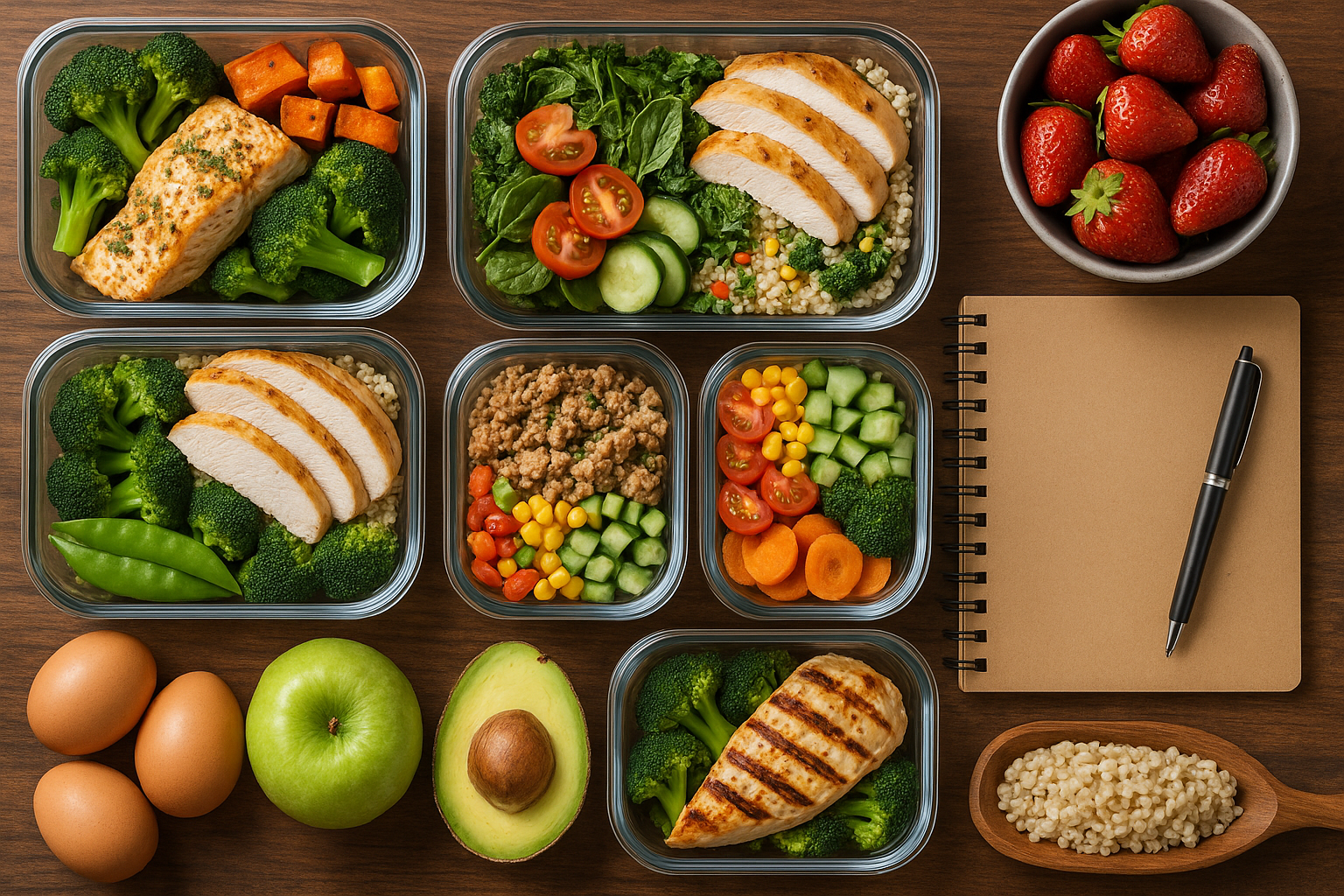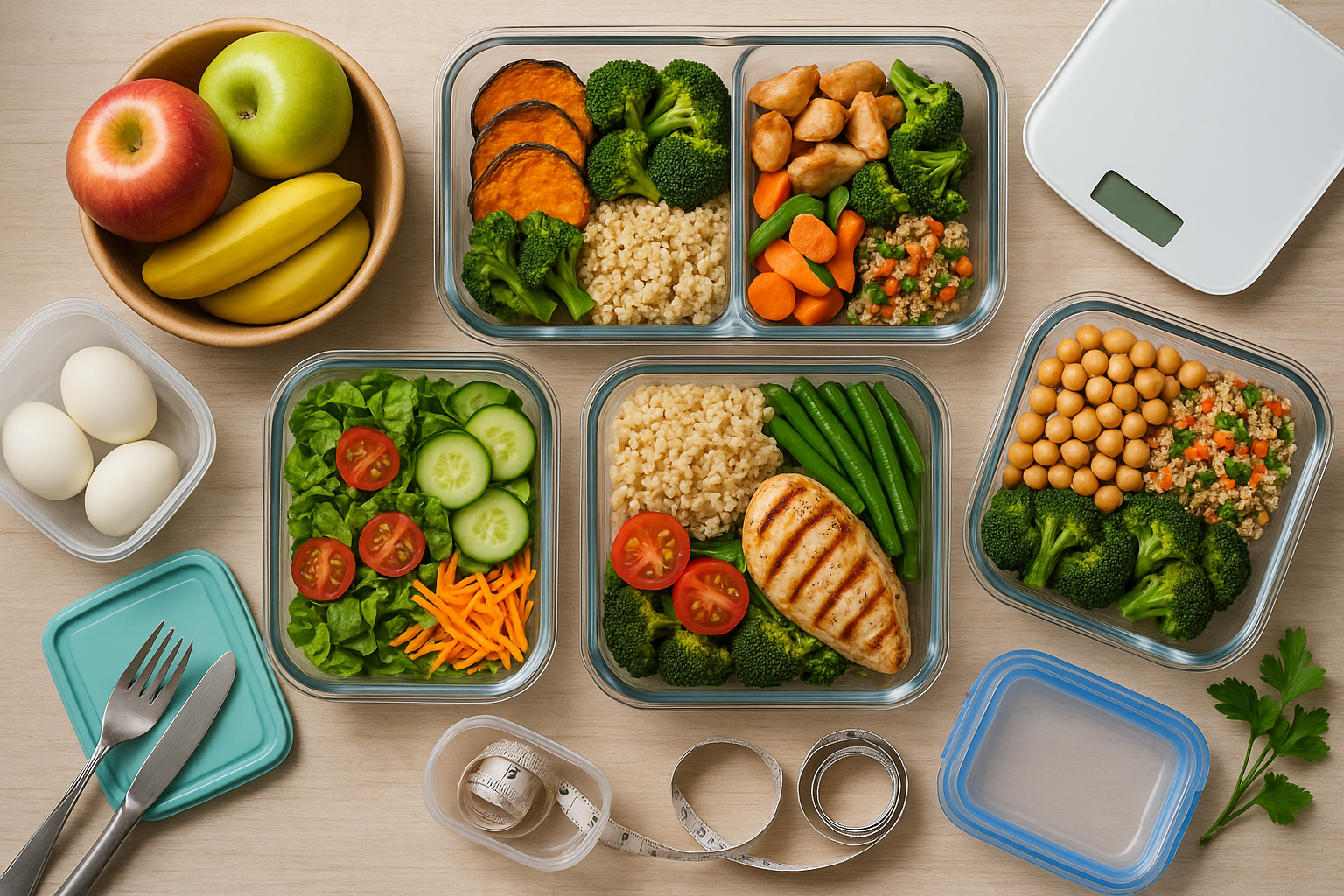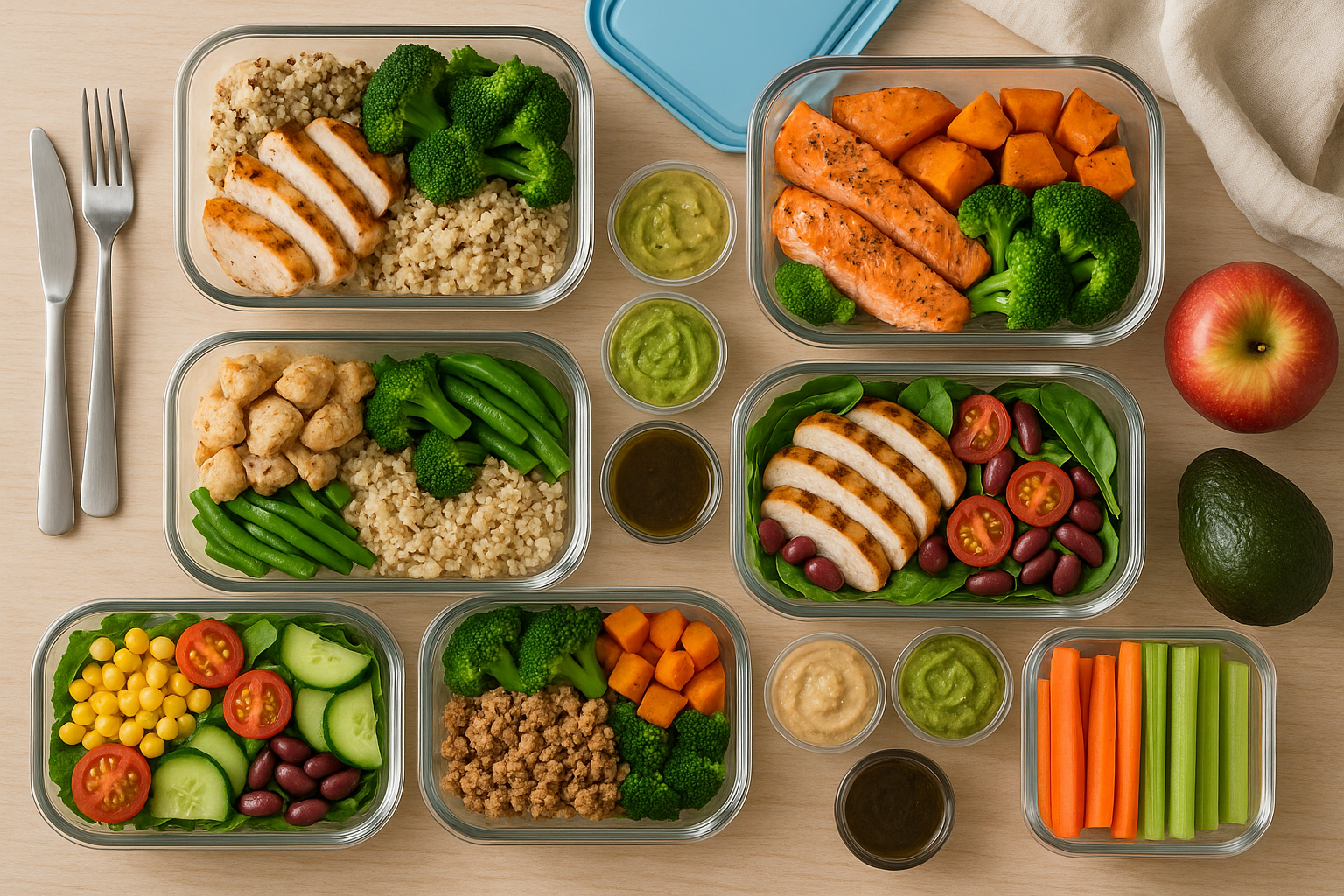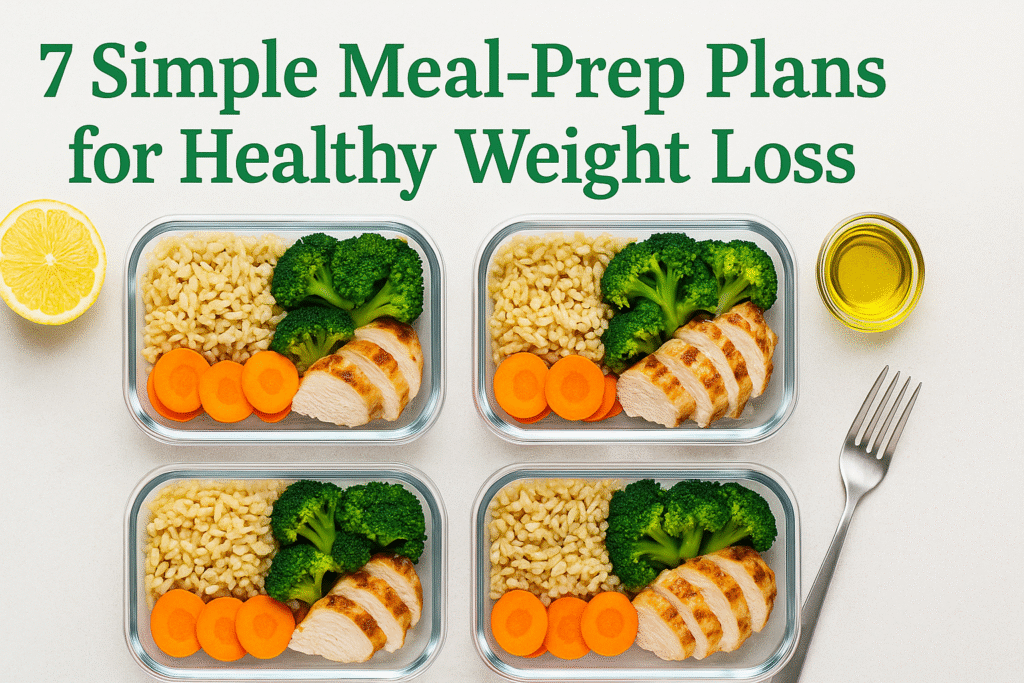Meal prep is one of the simplest, most effective tools for healthy weight loss. Planning and cooking food ahead of time reduces impulse eating, helps control portions, and keeps nutrition consistent even on busy days. Below are seven simple meal-prep plans you can rotate through to keep meals satisfying, balanced, and easier to stick with over the long term. Each plan includes a sample day, approximate portion guidance, a short grocery list, basic prep steps, storage tips, and a few swap ideas.
General guidelines before you start
– Aim for a modest calorie deficit tailored to your needs (consult a professional if unsure). Typical meal targets: 300–500 kcal per main meal, 100–250 kcal per snack, adjusted for activity level.
– Prioritize protein (20–35 g per meal), fiber (veggies, whole grains, legumes), and healthy fats (olive oil, nuts, avocado) to support satiety.
– Use consistent portion containers (e.g., 1-cup, ½-cup) so you can eyeball portions easily.
– Keep hydrated and include physical activity as part of a healthy weight-loss plan.
– Food safety: cool foods before refrigerating, store cooked meals in airtight containers, and consume within 3–4 days or freeze for longer storage.
Plan 1 — Mediterranean-Style Balanced Day
Overview: Veggies, lean proteins, whole grains, olive oil.
Sample day:
– Breakfast: Greek yogurt (1 cup) + ½ cup mixed berries + 2 tbsp chopped walnuts.
– Lunch: Grain bowl — ¾ cup cooked farro or quinoa, 4–5 oz grilled chicken breast, 1 cup mixed roasted veggies, 1 tbsp olive oil + lemon.
– Snack: 1 apple + 1 tbsp almond butter.
– Dinner: Baked salmon (4–5 oz) + large salad (mixed greens, cucumber, cherry tomatoes) with 1 tbsp olive oil and balsamic, ½ cup steamed green beans.
Grocery basics: salmon or chicken, farro/quinoa, Greek yogurt, mixed greens, vegetables, olives/olive oil, nuts, berries, lemon.
Prep steps: Roast a big tray of mixed veggies; cook a grain batch; grill or bake several portions of protein; portion into containers.
Storage/reheat: Keep dressings separate until serving; refrigerate up to 4 days; reheat protein and grains together.
Swaps: Use canned tuna or chickpeas instead of fish for budget or plant-forward option.
Plan 2 — Plant-Forward (Vegetarian) Day
Overview: High-fiber, plant proteins and wholesome carbs.
Sample day:
– Breakfast: Oatmeal (½ cup dry oats) with 1 tbsp peanut butter, 1 banana, and cinnamon.
– Lunch: Mason-jar salad — 1 cup cooked lentils, 2 cups mixed greens, shredded carrots, ¼ cup feta (optional), lemon-tahini dressing.
– Snack: Carrot sticks + 3 tbsp hummus.

– Dinner: Stir-fry with tofu (4–6 oz) + 2 cups mixed vegetables + ¾ cup brown rice; low-sodium soy sauce.
Grocery basics: oats, peanut butter, lentils, tofu, brown rice, veggies, hummus, tahini.
Prep steps: Cook lentils and rice in bulk; press and bake or pan-fry tofu; chop vegetables for salads and stir-fries.
Storage/reheat: Keep salads undressed; reheat stir-fry and rice. Use within 3–4 days.
Swaps: Tempeh or edamame for tofu; use quinoa instead of rice.
Plan 3 — High-Protein Day (Good for preserving muscle)
Overview: Emphasis on protein at every meal to increase satiety.
Sample day:
– Breakfast: Egg scramble (3 eggs or 1 cup egg whites) with spinach and mushrooms; 1 slice whole-grain toast.
– Lunch: Turkey & quinoa bowls — 5 oz lean ground turkey, ¾ cup quinoa, steamed broccoli.
– Snack: Cottage cheese (¾ cup) with cucumber slices.
– Dinner: Grilled shrimp (5–6 oz) + roasted sweet potato (1 medium) + side salad.
Grocery basics: eggs, lean turkey, quinoa, cottage cheese, shrimp, sweet potatoes, greens.
Prep steps: Hard-cook several eggs or make a breakfast egg muffin batch; cook quinoa; portion protein for the week.
Storage/reheat: Reheat protein and starches; cottage cheese best fresh (keep refrigerated).
Swaps: Use chicken or legumes if you prefer.
Plan 4 — Lower-Carb Day
Overview: Reduced starchy carbs, more non-starchy vegetables and protein.
Sample day:
– Breakfast: Greek yogurt (1 cup) with 1 tbsp chia seeds and a handful of berries.
– Lunch: Chicken Caesar-style bowl — 5 oz grilled chicken, large romaine salad, roasted asparagus, 1 tbsp parmesan, light dressing.
– Snack: A small handful (about 1 oz) of almonds + 1 celery stalk.
– Dinner: Zucchini noodle “pasta” with turkey meatballs (4) and a tomato-basil sauce.

Grocery basics: zucchini, ground turkey or beef, chicken breast, Greek yogurt, almonds, salad greens.
Prep steps: Spiralize zucchini when ready to eat (or spiralize and store dry between paper towels); bake meatballs in batch; prep salad components separately.
Storage/reheat: Reheat meatballs and sauce; keep zucchini noodles slightly undercooked for best texture when reheated.
Swaps: Replace meat with tofu or tempeh for a lower-carb vegetarian option.
Plan 5 — Budget-Friendly Meal Prep
Overview: Affordable staples, minimal waste, filling and nutritious.
Sample day:
– Breakfast: Overnight oats (½ cup oats, 1 cup milk or dairy alternative, 1 tbsp flaxseed, cinnamon).
– Lunch: Bean & rice bowl — 1 cup cooked brown rice, ¾ cup black beans, salsa, sautéed peppers/onions.
– Snack: Orange + 10 raw almonds.
– Dinner: Baked chicken thighs (1 medium) + roasted carrots and potatoes (1 cup total).
Grocery basics: oats, brown rice, canned beans, carrots, potatoes, chicken thighs, bulk frozen veggies.
Prep steps: Cook a large pot of rice; roast a sheet pan of root vegetables and chicken; portion beans and rice into bowls.
Storage/reheat: Freeze individual portions if you won’t eat within 3–4 days.
Swaps: Use canned tuna or eggs for variety; replace chicken with a hearty lentil stew for vegetarian variation.
Plan 6 — 30-Minute Quick Prep Day (For busy schedules)
Overview: Minimal cooking, rely on quick-cook proteins and frozen/fresh veggies.
Sample day:
– Breakfast: Smoothie — 1 cup spinach, 1 scoop protein powder, ½ banana, 1 cup unsweetened almond milk, 1 tbsp nut butter.
– Lunch: Rotisserie chicken salad: 4–5 oz shredded rotisserie chicken, mixed greens, cucumber, cherry tomatoes, olive oil + vinegar.
– Snack: Greek yogurt + 1 tbsp granola.
– Dinner: Shrimp & veggie sheet pan — frozen shrimp, frozen mixed veggies, 1 tbsp olive oil, lemon and herbs; serve over microwaveable brown rice.
Grocery basics: frozen shrimp, rotisserie chicken, frozen veggies, protein powder, microwaveable whole grains.

Prep steps: Portion smoothie ingredients into freezer bags for quick blending; prepare salads in advance without dressing; use microwaveable rice for fast dinners.
Storage/reheat: Quick-cook options are best eaten within 2–3 days for freshness.
Swaps: Use canned salmon or smoked salmon in salads for variety.
Plan 7 — Minimal-Ingredient / 5-Ingredient Prep
Overview: Perfect for beginners or those who want low-fuss meals.
Sample day:
– Breakfast: 2 boiled eggs + 1 piece of fruit.
– Lunch: Tuna salad — canned tuna (in water), ½ avocado, 1 cup chopped cucumber, lemon, salt & pepper; served on a bed of greens.
– Snack: Cottage cheese (½ cup) or a small handful of nuts.
– Dinner: Baked chicken breasts (4–5 oz) with roasted broccoli (1.5 cups) and ½ cup cooked quinoa.
Grocery basics: eggs, canned tuna, avocado, chicken breast, broccoli, quinoa.
Prep steps: Hard-boil several eggs; bake multiple chicken breasts; steam/roast broccoli; portion into containers.
Storage/reheat: Eggs and salads keep 3–4 days; baked chicken reheats well.
Swaps: Replace tuna with chickpeas for plant-based option; use cauliflower rice instead of quinoa for lower carbs.
Quick tips for success
– Use consistent portioning containers and label with dates.
– Rotate proteins and veggies to avoid boredom.
– Batch-cook staples (grains, proteins, roasted vegetables) once or twice a week.
– Make sauces/dressings in small jars to keep meals flavorful without extra sodium or sugar.
– If you’re short on time, rely on healthy convenience options: rotisserie chicken, canned beans, pre-washed greens, frozen vegetables.
– Track how your meals make you feel (energy, hunger, fullness) and adjust protein, fiber, or fat as needed.
– For sustainable weight loss, aim for a balanced, varied approach rather than extreme restriction. If you have medical conditions, allergies, or special dietary needs, consult a registered dietitian or your healthcare provider before making major changes.
Use these plans as templates: mix and match meals from different plans, adjust portion sizes to your energy needs, and aim for consistency. Meal prep won’t replace movement, sleep, or stress management, but it makes healthy eating far more doable and reliable while you lose weight in a safe, manageable way.

